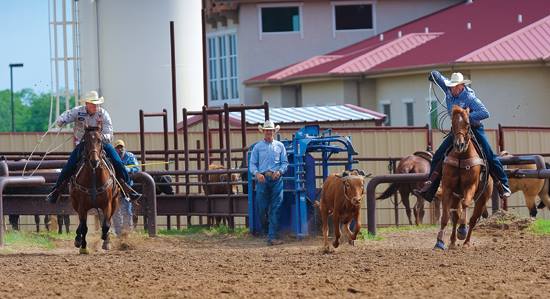There are different styles of roping, and you learn which ones work best in different situations from experience. Those of us who’ve been in the industry for years and years know what to expect at the big ropings, because we’ve been there. The basic rules of the game really haven’t changed. The header’s got to get out of the barrier and use one of the three legal head catches to catch the steer, the heeler has to catch two feet and the header has to face. The team that can do that on the most consistent basis that day wins. Yes, you need a little help with the luck of the draw, but it still boils down to avoiding mistakes and relying on fundamentals when you get to an average roping.
In all scenarios, you obviously want to be on your best horse. That means picking the right horse for whatever conditions you’re facing. The score is shorter at the George Strait (Team Roping Classic) than the BFI, where the cattle are also bigger and stronger. A few guys have that great versatile horse you can do either on, but most of us have to make the appropriate selection and choose which horse fits each setup the best.
The header starts and finishes the run, so there’s a lot of pressure there. Getting a good start is so critical, especially if you don’t draw toward the top of the herd every time. Scoring is especially tricky if you get a slow or fast steer. That’s why you need a horse that’ll let you decide when to leave, without rearing or running through the bridle.
You need to rope aggressively and rope smart when you’re roping in an average. Big-money events can make you feel a little more tentative, but you should take your first available shot. You don’t want to be too aggressive or borderline stupid. But you can be too conservative and end up passing up your best shot to take a lower-percentage one if you back off too much.
The faster you’re running down the arena, the more you need to break the steer’s momentum down to make it as easy as possible for your heeler. As a header, it’s your job to make your partner’s job easy. Saying, “He was loose when I caught him” doesn’t cut it. This is a team sport, and that means teamwork.
It’s really important to communicate with your partner and know what he or she likes. Some heelers want steers broken down and slowed down, and others like you not to break steers down too much and for you to move steers more. Some of the younger guys ride a little higher and throw a little faster. The bottom line here is, talk about it and do what works for your team.
I’ve come to the conclusion that no matter how much you prepare, how good a horse you have and how high your hopes are for winning at the big events, about half of it comes down to whether or not it’s your turn. You have to be a little lucky and draw at least decent to have a chance. Then you need to execute and take advantage of any breaks you get. That’s what keeps us all going back. I’ve been going to the BFI for 25 years and I’ve won it once. The odds just aren’t that great for winning one of the majors, because so many factors are involved. That’s what keeps us all coming back. On any given day, it’s anybody’s game to win.









